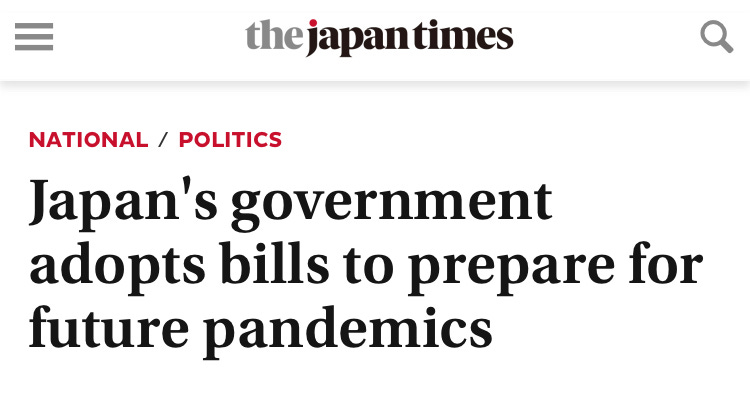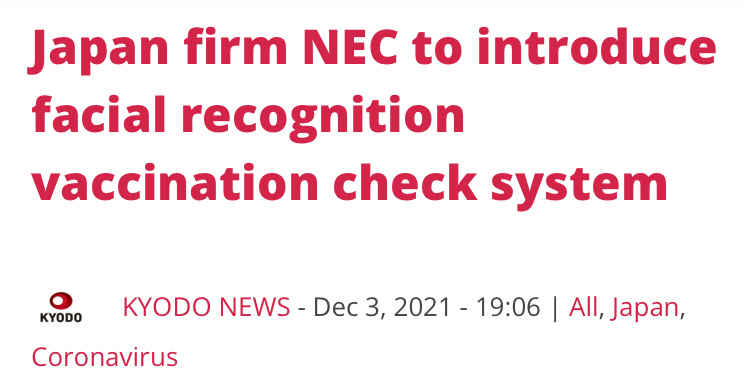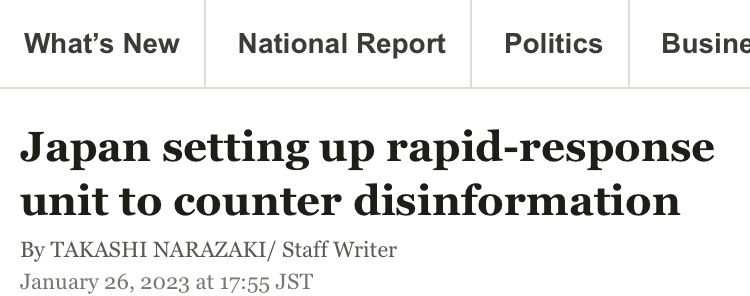Japan is now winding down Covid craziness. Universal masking will no longer be requested from March. Covid’s downgrading in May will mean the end of daily news reports of cases numbers. And the next booster campaign will start in autumn, with the jabs still being publicly funded and high-risk groups likely being allowed to get their 6th shots earlier. So what is left for the government to do? Get ready for the next pandemic!
Be prepared
Fumio Kishida, prime minister of Japan and pharma sales rep, recently laid out the government’s plans in The Lancet.
Japan supports achieving the goal of accelerating development of research and development for PPR [prevention, preparedness, and response] and reiterates the importance of assuring equitable access to vaccines, diagnostics, and therapeutics under the overall goal of UHC [universal health coverage].
So what is PM Kishida going to do for PPR? Why, give himself more powers of course!
The bills to revise the COVID-19 special measures law and the cabinet law allow the prime minister to exercise the right to issue necessary instructions to central government agencies and prefectural governors more quickly when an infectious disease that could have a considerable impact on people's lives and economic activity occurs.
The government will also establish an infectious disease crisis management agency at the Cabinet Secretariat possibly in autumn this year. The new agency, to be headed by a deputy chief cabinet secretary, will be in charge of drawing up the government's action plans and specific measures, as well as general coordination.
Currently, the prime minister is allowed to exercise the right to give instructions only when a state of emergency or pre-emergency, which involves movement restrictions, is being declared.
The conventional wisdom in Japan is that the government allowed Covid to spread in 2020 because it didn’t tighten border controls quickly enough or conduct enough tests. The fact that Japan had minus excess deaths in 2020 is doesn’t matter. The above proposed changes along with the recently strengthened Quarantine Act demonstrate the government’s commitment to swiftly introducing excessive entry restrictions and going on a test-and-trace witch hunt right from the first PCR positive whenever the next opportunity arises.
According to the Sankei Shimbun, “necessary instructions” outside of emergency periods will likely relate to the medical response, such as the PM telling governors to quickly secure medical personnel and hospital beds. But the problem with Japan’s medical response has never been speed; it’s always been its fundamental dysfunctionality, as even BBC has recently got round to noticing
Elderly people who are getting infected in nursing homes or in community clusters are not receiving prompt treatment, says epidemiologist Kenji Shibuya, a director at the Foundation for Tokyo Policy Research.
Faster treatment can help, he says, but because of Japan's classification of Covid as a Class 2 or "very dangerous" illness, only government-designated hospitals can treat the infected. And they have been overwhelmed by the surging caseload.
This problem of limited hospital access will be solved with Covid’s downgrading, and the Infectious Diseases Act was revised at the end of 2022 to ostensibly avoid this problem in future pandemics. But the reasons it has continued for over 3 years are that 1) it allowed politicians to create the illusion of an emergency by filling up limited beds with mild cases, 2) reports of overwhelmed hospitals generated demand for the jabs, and 3) the designated hospitals received huge amounts of public money while non-Covid hospitals got to avoid all the rigmarole. So the national government, pharma companies, and medical establishment have little incentive to avoid a repetition and plenty of incentive to do it all again.
The 100 day dash
More importantly, what kind of action plans will the new Infectious Disease Crisis Management Agency come up with? PM Kishida gives us a clue.
Innovation is needed to facilitate a more enabling global ecosystem to make rapid research and development of medical countermeasures possible, as proposed in the 100 Days Mission.
The 100 Days Mission was proposed by the G7 in June 2021, when the, er, drawbacks of mRNA technology weren’t quite as apparent. It makes Operation Warp Speed look positively cautious.
The first 100 days when faced with a pandemic or epidemic threat are crucial to changing its course and, ideally, preventing it from becoming a pandemic. In those 100 days, non-medical public health interventions like social distancing, isolation, contact tracing and personal protective equipment (PPE) are essential, but the three best weapons we have to defeat a pathogen threat are diagnostics, therapeutics and vaccines.
In the first 100 days from a pandemic threat being identified (defined by when WHO declares a PHEIC [Public Health Emergency of International Concern]) we should aim for the following interventions to be available, safe, effective and affordable:
a Accurate and approved rapid point of care Diagnostic tests;
b An initial regimen of Therapeutics; and,
c Vaccines ready to be produced at scale for global deploymentThis requires preparation, investment, and a no-regrets approach. It also requires a combined and concerted effort between governments, industry and international organisations.
Just 100 days to flatten the curve! With any luck, the Japanese will only have to mask up for 3 months rather than 3 years.
The Japanese were slow to start jabbing last time because they had to rely on overseas manufacturers. But Daiichi Sankyo will help to ensure that won’t happen again.
That’s an interesting decision considering that the company’s new Covid mRNA jab hasn’t yet been given emergency approval based on its “presumed effectiveness” (i.e., antibody response). That particular regulatory innovation will come in handy during future pandemics too, I’m sure.
Once the jabs are ready to be injected, Japan will be able to speed up future vaccine campaigns by allowing willing jabbers to use their My Number Cards (Japan’s digital ID) to confirm their eligibility at vaccination centres, eliminating the need to wait for local authorities to send out paper invitations.
And if you want to enjoy whatever benefits are being offered to those who get the shots, you won’t need to worry about forgetting your vax pass since NEC has already developed a vax-certification check system that uses facial recognition.
It’s so convenient that you won’t even need to take your mask off.
But never fear, anti-vaxers. Like the last time the government attempted to popularise vax passes, a negative test option will most likely be available, so you’ll have no reason to whine about discrimination.

But what happens if the “no-regrets approach” to churning out vaccines within 100 days leads to jabs that turn out to have nasty side effects? Simple. Declare inconvenient facts to be “disinformation.” As if you didn’t know.
So Japan will soon be fully prepared to respond to the next outbreak of fevers, runny noses, and PCR positives by telling the population to stay home, mask up, and jab away all over again. But the time frame will be so much shorter! The government clearly can’t wait for the chance to turn up its pandemic response to Max Power.










If I had any doubts. I am now 100% convinced that Kishida is a putz. I can do a better job. Then again, so could any homeless person on the street. Guy Gin is correct in calling him a pharma sales rep. I think it's time for everyone in Japan to ignore politicians and become totally independent of the government.
If you want to know when the next pandemic will occur, check the US presidential elections calendar. Covid and mail in ballots work together ^^